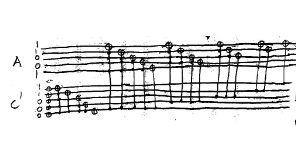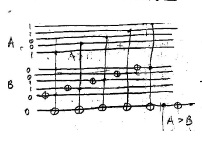Chris Pollett > Students > Yunxuan
Print View
[Bio]
[Blog]
[Final Step of Shor's and Grover's Algorithms]
[Threshold of Error Correction]
[Random-kSAT-Generator: Version 1]
[Random-kQSAT-Generator: Version 2]
[Random-kQSAT-Generator: Version 3]
[Antiferromagnetic Heisenberg Model]
[Random-kQSAT-Generator: Version 4]
[Random-kQSAT-Generator: Version 5]
[Random-kQSAT-Generator: Version 6]
[Thesis]
Division and multiplication by 2 and comparing two numbers to see whether A>B is greater are very easy to do. Addition and subtraction are slightly harder but still simple. Squaring is manageable. The hardest one of all is A modulus B. It is not conceptually hard but it requires piecing together all the previous circuits described above.
Subtraction Circuit
This circuit computes the operation A-C'.

Comparison Circuit
This circuit returns 1 if A>B.

Squaring Circuit
This circuit computes A*A.
